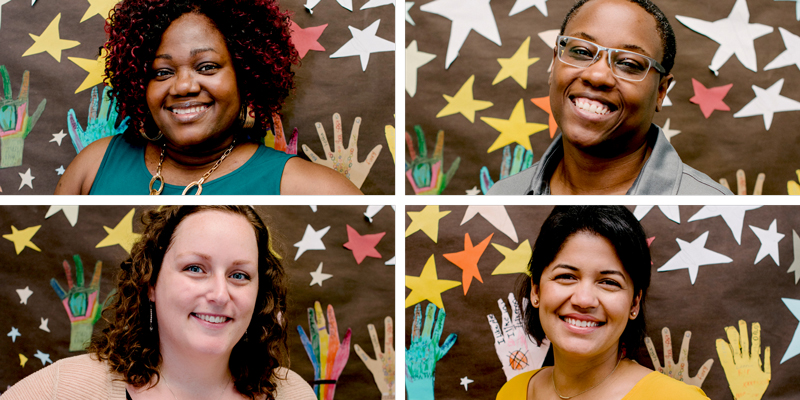By Marni McEntee | Photographed by Hillary Schave
As of the most recent academic year, Madison is home to four community schools, which integrate services like health care, academic tutoring, mentoring, food access through healthy snacks and food pantries, and parent leadership opportunities into elementary school sites.
The idea behind the increased services is to tackle persistent problems in these four sites, which are among the lowest academically performing schools in the Madison Metropolitan School District. Their populations face a host of problems, from high mobility due to homelessness and housing insecurity, to food insecurity, high numbers of families who speak English as a second language, and other issues.
Mendota and Leopold elementaries were the first two schools selected to be community schools, launching in the 2016-2017 school year. The model was implemented starting last year at Hawthorne and Lake View.
“One of the biggest things in becoming a community school is looking at what barriers we can eliminate, because the idea is that the more we can have to support and strengthen the family, that will have a positive impact on the students,” says Mendota Principal Carlettra Stanford.
Women are at the helm of each new school model, serving as community resource coordinators. They juggle the many services made available and work hand-in-glove with staff, parents and community stakeholders to make sure those resources are put to good use.
Here’s a look at the women who are helping the Madison school district make the leap to the community school model; their backgrounds, motivations and hopes for the students.
SONIA SPENCER
Mendota Community School
It’s a warm June evening, and the Mendota Community School grounds are buzzing with activity. Sonia Spencer, the school community resource coordinator, is standing at the Family Fun Night check-in table, and kids rush up to her, blurting out little updates about their lives and coming in for hugs.
It’s one of several school events each year. Its goal is fun, of course, but also to give Mendota families another opportunity, outside the workaday world and school time, to engage with the school’s staff and with other parents to help boost academic achievement and to ease the many barriers to success that they face: poverty, a high mobility rate, homelessness and trauma.
“The way we describe community schools and what’s happened here is that our school has become a hub of the community and that’s why it’s important,” Spencer says.
Mendota, on the city’s North Side, also hosts group parent-teacher conferences, making it easier for parents to liaise with each other about their kids’ educational challenges. Evening events typically come with dinner.
The school has been a resource for employment, transportation, after-school activities and its food pantry is set up to fulfill the additional needs of families whose kids already eat free break- fast and lunch at school. It even offers a holiday store so that people can buy low-cost gifts. It all helps ease the bur- den families face, so their kids can focus on learning.
Both Spencer and Mendota Principal Carlettra Stanford have the importance of education in their DNA. Stanford is an East High grad and went to UW-Madison before ascending through various positions in the district to her current post. Her mother, Carolyn Stanford Taylor, is the first African-American State Superintendent of Public Instruction, replacing Tony Evers when he became governor. (Read about the new superintendent on P. 14 of the August issue.)
Spencer and her family came as refugees from their native Angola to Milwaukee when she was 7 and they eventually moved to Madison. She credits her African parents’ strict belief in the value of education—and their respect for authority, including teachers—for her success and for her views on raising her three kids with African values. Her oldest son is attending Edgewood College this fall in the education department, and her youngest daughter has taken an interest in becoming an educator as well.
Spencer, who started out as Mendota’s parent-liaison when it became a community school, says she’s seen positive results.
“With any new initiative, it takes time to really build it and have people kind of believe in it. But, because of the work that we’ve done in the past here, and because of the transition to being a community school, we have seen a lot of improvement with our families,” she says.
She says of the school’s parents, “I have seen them rise. I’ve seen them obtain stable housing and get transportation. And, I’ve seen them more engaged with the scholars at school.”
Another chance to celebrate their community ties happens this month at Mendota’s annual block party on Aug. 24.
ERICKA BROWN
Hawthorne Community School
Ericka Brown knows a bit about keeping kids busy, safe and healthy. Much of it she learned as a child, after her mom brought the family to Madison from Chicago back in the late 1970s.
Brown’s mother, Doris Brown, was a lead advocate for a community center in their Allied Drive neighborhood as a way to keep kids occupied and off the streets during the summer. Over time, the neighborhood, with the help of churches and other organizations like Madison School and Community Recreation, was able to ramp up the services that moms like Brown had lobbied for.
The experience left Ericka Brown, now Hawthorne’s community resource coordinator, with a passion for helping others, particularly youngsters.
“So, that’s where my love of community comes from,” says Brown. Early in her career, Brown had a childcare business and later served as a program leader for MSCR.
Brown and her two siblings didn’t have it easy. Their mom had four strokes while they were growing up. “You know, there were tough times. Just that anxiety of day-to-day living was there. School was our safe haven.”
Brown hopes that Hawthorne will provide its students that kind of refuge. Some 80% of its students, who are nearly equally split between African-American, white and Asian ethnicities, are on the free and reduced lunch program.
Hawthorne’s population is highly mobile, due to either homelessness or housing insecurity.
“Even that time that they’re here with us we try to give them that time of rest until their next step,” she says.
Hawthorne, as well as Lake View Community School, were the most recent to adopt the community school model. School staff have outlined their priorities thus far as meeting students’ basic needs, wellness for students and staff, and academic support.
To those ends, the school started a food pantry, offers homework help for parents to be able to aid their kids, has three community dinners a week and is planning to hire a mental health professional for the students, among other things.
Principal Beth Lehman says that Brown has been instrumental in getting families more involved with the school, partly because she’s been so involved, through MSCR, over the years.
“She really already had built up quite a system of trust and respect and comfort in being in our school with a lot of our families,” Lehman says.
Perhaps the most visible project that the new community school has undertaken is the cleanup and painting of a tunnel under East Washington Avenue that many kids walk through to and from school. The work, paid for by grant funds, will be done through Dane Arts Mural Arts and will be unveiled in October.
Such visible accomplishments mean the world to Brown.
“I just love this position. It’s strategic and it’s driven by what’s needed,” says Brown, whose face lights up with an easy smile. “When I tell people about the upcoming years and what we can do, you get that spark back in their eyes. Like, something different, you know?”
ROSALIA GITTENS
Leopold Community School
Rosalia Gittens knows from experience just how much schools can do to help families. Gittens, who is from Panama, was 10 when her mother died of lupus and 13 when her father died from diabetes. She and her three siblings were placed with relatives in separate homes, because no one could afford to take them all.
She found that her teachers were the ones who rallied around them when she and her siblings needed anything.
“If we needed food, there was food. I remember I needed clothing and shoes and the teachers organized to provide them. The school didn’t have any resources. It was literally the teachers doing everything,” she says.
Gittens immigrated to the U.S. when she was 18 and joined her sister here in Madison. After earning a bachelor’s degree in business, she later decided that teaching suited her better, so she got an emergency teaching credential, offered to bilingual candidates.
Gittens, who became the community resource coordinator at Leopold Community School last year, says that her life experience is very similar to what many Leopold kids contend with every day. Mired in poverty, homelessness and facing other societal problems, they often come to school hungry, stressed and without proper clothing.
There’s an additional layer of stress for the school’s majority Hispanic population, who fear being deported in the current federal crackdown on immigrants. Many, Gittens says, have a difficult time seeking help, feeling like they must bear the burden alone.
When they do allow others to help them, Gittens says she can work with school staff, community partners and others to provide it.
The neighborhood, on the border of Fitchburg, lacks some of the other resources that might help, such as easily accessible grocery stores or a nearby neighborhood community center, says longtime Madison teacher Kim O’Donahue, who moved to Leopold this school year to teach fifth grade because she sees the value in the community school model.
Leopold, which has nearly 750 students, is set up to meet many of its families’ needs that are beyond getting an education. A food pantry, English classes for adults and cultural identity classes for students are among its offerings. In addition, teachers can access things like healthy snacks if a student arrives hungry or snow pants for a kid who has none.
Other innovative programs have included monthly classes at Edgewood College for staff and parents to learn how to create a science night, which O’Donahue says was well-attended.
“It gets you in the mindset of teaching that whole child,” O’Donahue says of the community school model. “Naturally, you’re strengthening your core instruction because more kids are engaged, more kids are comfortable, families are comfortable, families are engaged and we’re all on the same page.”
RACHEL DETERDING
Lake View Community School
Racheel Deterding has some deep roots at Lake View Community School. The Madison native attended Lake View, on the city’s North Side, as a kid, and two of her own teachers still work at the elementary school.
“My lifelong dream was to be a teacher,” Deterding says. “Teachers made a huge difference in my life and school was a very positive experience for me.” She doesn’t fall far from the family tree either. Both Deterding’s parents have education degrees, though her mother moved into health care and her father became a social worker.
After graduating from UW-Madison with a degree in Spanish literature, she built her career in various positions, first with AmeriCorps as a literacy tutor, and later as an assistant in Chavez Elementary’s dual language immersion program. She later returned to Lake View as the MSCR Site Director for five years before leaving the academic world for a brief time to work as a community social worker.
Last year she was named Lake View’s community resource coordinator.
It’s been a challenging year, Deterding says, working to find common ground among all the stakeholders who will shape the school’s initial goals. She says certain themes continue to emerge, such as setting up a system to meet kids’ basic needs.
Most of the 260 kids come from low-income families, and 42% of the kids speak a language other than English at home.
Also, from September 2018 to April this year, almost 2,000 visits were logged at the school nurse’s office, and 91% of the student population made those visits.
“The most common reason was basic needs, so food, sleep, hygiene, lack of proper clothing,” Deterding says. “The second main cause was gastrointestinal issues, which could potentially be related to nutrition, or maybe anxiety.”
But, Deterding says, hope can be found in the midst of such heartbreaking statistics.
“It’s been simultaneously the toughest thing about this job and also the most rewarding thing about this job, because you look at some of this data and you’re like, ‘wow, this is such a sad story.’ But, there’s a great potential for improvements.
“And, people see that and it really impacts them, intellectually and emotionally and then they’re motivated to band together to do this work. This work is heavy work. It’s hard work. But it’s the right work to be doing.”
Lake View’s social worker, DeShala Walker, shares an office with Deterding and the school’s parent liaison. She’s been at Lake View for nearly three years and says she’s seen an uptick in parent involvement and use of services such as transportation to school, use of the food pantry, job search and housing support, and mental health counseling since Lake View became a community school.
“With the three of us, we all have similar mindsets and individual strengths to help parents,” Walker says.
Deterding says she considers her work at Lake View as a calling, not just a job.
“I feel really lucky that I found a position like this,” she says. “And I’m really happy to be helping to bring people together to make this change sustainable at our school.”





Comments are closed.